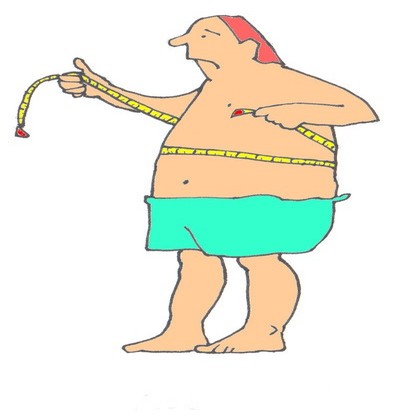Obesity Part 2. Assessment and causes
Obesity
Obesity is generating an enormous amount of attention in the media – driven by controversy (is it a disease or a risk factor?), by increasing awareness of its hazards and by novel new and seemingly effective medication which I discussed in my last Blog
I have two reasons for approaching this subject now – the first is the great interest currently being aroused by the development of new anti-obesity medications and the second is the publication of the most recent edition of The Clinical Medical Journal, produced by the Royal College of Physicians . The August edition is taken over by a number of articles on a variety of aspects of obesity – https://www.rcpjournals.org/content/clinmedicine/23/4/.
I thought that it might be interesting to my readers to read a summary of some of these articles.
The problem of obesity
“Obesity is a chronic, progressive and relapsing disease, characterised by the presence of abnormal or excess adiposity that impairs health and social wellbeing.”
Obesity is a major public health challenge that contributes directly and indirectly to multiple health conditions, health inequalities and premature death. Since 1975, obesity has tripled worldwide. The UK has the highest rates of obesity in Europe with most of the adult population (64%) now classed as overweight, of which 26% are classed as obese. Obesity is a risk factor for type 2 diabetes mellitus (T2DM), hypertension, cardiovascular disease, chronic kidney disease, obstructive sleep apnoea (OSA), gastro-oesophageal reflux, osteoarthritis, metabolic-associated fatty liver disease, subfertility/infertility and cancer.
Prevention is what is needed to reduce the high levels of disease in later life and thus reduce the enormous individual and societal costs to both the health and care systems. The current cost of obesity to the NHS is over 6 billion pounds per annum, set to double over the next 30 years. The cost to society as a whole is hugely greater.
Assessment of obesity
Body mass index (BMI), calculated as weight in kilograms divided by height in metres squared, is universally used to define the degree of overweight or obesity:
-
- BMI 25-29.9 Over weight
- BMI 30-34.9 Obesity Class 1
- BMI 35-39.9 Obesity Class 2
- BMI 40 + Obesity Class 3 (Morbid obesity)
Other measures can be used to supplement BMI as measures of excess body fat:
- Waist circumference. This should be below 102cm (40 inches) for men and 88cm (35 inches) for women)
- Waist to height ratio is calculated by dividing waist circumference by height in the same units. Increased health risks are associated with a WHR of 0.5 to 0.59 and further increased risk if the ratio is >0.6.
The causes of obesity
It’s complicated! The quick answer is that obesity is caused by consuming more calories as food than is expended as calories in physical activity. However the contributing factors to these two elements are legion.
- Genetics: There are three types of genetic obesity: single gene, multiple genes and as an element of a genetic disease. For most obese people it is the multiple gene combination which contributes. The main effect is a suppression of appetite regulation. People with the “wrong” genes find it difficult to deal with hunger – their appetite is not easily satisfied.
- Diet: This is very much a society problem – we live in an “obesogenic” environment. Elements include fast-food chains, meal deals, BOGOF promotions, ever larger fizzy drinks containers, and the easy availability of inexpensive ultra-processed food. The food industry works tirelessly to get us to eat more. Our prehistoric hunter-gatherer forefathers needed to take every opportunity they could to eat. Now we have universally available grub, enhanced by the lower cost of food and drinks, increased marketing of food products and improved accessibility of food in convenience stores and vending machines. Our high streets are lined with eateries, tempting us in with their tasty offerings – it would take a will of iron to resist.
- Exercise: This blog is all about physical activity but I have left myself no space today to go into this aspect of obesity and its management. However I do believe that lack of exercise is a major factor in our epidemic of obesity and that increasing exercise taking is the cornerstone of the prevention and management of this problem.
More next time!
Subscribe to the blog
Categories
- Accelerometer
- Alzheimer's disease
- Blood pressure
- BMI
- Cancer
- Complications
- Coronary disease
- Cycling
- Dementia
- Diabetes
- Events
- Evidence
- Exercise promotion
- Frailty
- Healthspan
- Hearty News
- Hypertension
- Ill effects
- Infections
- Lifespan
- Lipids
- Lung disease
- Mental health
- Mental health
- Muscles
- Obesity
- Osteoporosis
- Oxygen uptake
- Parkinson's Disease
- Physical activity
- Physical fitness
- Running
- Sedentary behaviour
- Strength training
- Stroke
- Uncategorized
- Walking



Hello Hugh, So many aspects of strength training for oldsters, other than reduction of fatty tissue. In my case, the affliction of ‘dysfunctional’ and/or loss of muscle mass. The reduction of height which I’ve attributed to
an aging factor, i.e. spinal shrinkage, so to speak. My waist no longer exists together with lost abdominal support,
something like ‘ herniated bulging’ in certain places.
Hard to describe, a blow to residual vanity in my old age. My adult weight is less than ever. Thanks for your interest!
I’m trying to find my feet and regulate activity. The book is great….perhaps too comprehensive for my idle brain.
Thanks Bernard – and congratulations on you perseverance! Hugh
Good article Hugh. England overweight can be a sensitive issue,bit needs to be called out.
Thanks Gerry – always a difficult balance between concern about the ill effects of obesity and “fat-shaming”. Hugh